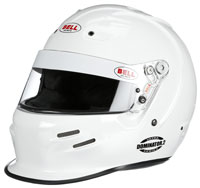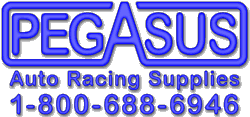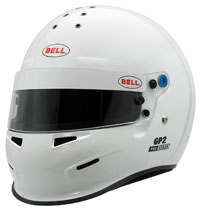How should a helmet fit?
A helmet should be tight but not uncomfortable. You should feel contact all the way around your head, and the pressure should be evenly distributed. Keep in mind the padding will break-in a little, so a new helmet should feel tighter than your old helmet.
How do I measure my head?
Use a flexible tape measure (not your metal shop tape measure) approximately one inch above the eyebrows in front and at a point in the back of the head that results in the largest possible measurement.
How are helmets rated?
The two main helmet rating organizations in the USA are the Snell Memorial Foundation and the SFI Foundation. Snell certifies racing helmets as M, SA, or K.
M stands for Motorcycle (or Motorized vehicles). M rated helmets are used for motorized highway vehicles and for racing that does not require a fire-retardant lining. The M rating also requires a larger eyeport for a wider range of vision. The M rating is typically updated every 5 years.
SA stands for Special Application. SA rated helmets are used in competitive automobile racing and require a fire-retardant lining. SA helmets are also subjected to additional testing including a test that simulates a roll bar impact. The SA rating is currently revised every 5 years.
K stands for Karting. K rated helmets are subjected to the same tests as SA helmets except they do not require a fire-retardant lining.
Please consult your sanctioning body for specific helmet requirements.
How do I care for my helmet?
Helmets should be stored clean and dry, away from extreme heat or extreme cold. Keep your helmet away from petroleum products or other corrosives as these can have unexpected results on even the strongest composite materials and resins. Helmets should be stored out of direct sunlight, preferably in a padded bag. Dropping the helmet, even from just a few feet off the ground, can damage the shell. The shell and the inner liner may be cleaned with warm soapy water.
What is the proper way to clean a face shield?
Avoid using paper towels, as these can scratch the shield. Thinners, solvents, plastic polishes, and other harsh chemicals can destroy the shield material. Chrome, iridium, and other reflective coatings can also be damaged by ordinary household window cleaner. On most shields, a mild soapy solution (preferably sprayed on) and a clean, soft rag will do the job.
We recommend lens cleaner and cleaning cloths formulated for coated lenses. These are available at most drugstores, camera shops, or optometrists. Use a liberal amount of lens cleaner and do not scrub the shield. Gently wipe away the dirt and pat the shield dry.
The inside of Bell Fog Free shields and inserts should be cleaned by rinsing with warm water only. Automotive wax (not "cleaner wax", which has abrasives) can be used to protect the fog free coating.
Why does my Bell Fog Free shield look distorted?
Bell Fog Free shields have a coating on the inside which abosorbs moisture. It can reach a saturation point and may lose some of its ability to absorb moisture over time. If the Fog Free shield appears distorted, please follow this procedure:
1. Confirm that the protective cling film on the outside of the shield has been removed.
2. Re-examine the shield by looking through it as you normally would while wearing the helmet. Looking at the shield sideways can show distortion that will not affect normal vision on track.
3. If the shield has a hazy or milky appearance, run warm water onto the inside of the shield and gently wipe off with a clean, soft cloth. You can also use automotive wax (not "cleaner wax", which has abrasives) to clean the inside of the shield without damaging the Fog Free coating.
4. Make sure to use wam water or automotive wax and wipe the entire surface area of the inside of the shield.
5. Repeat Step 3 if the shield until the shield is clear.
What is the Bell SRV shield system?
Bell introduced the SRV shield pivot system in 2006, and all Bell models now use an SRV system. The SRV system has a slide mechanism that allows the driver to adjust the tension on the shield, and it also allows the driver to choose many more opening positions. When properly adjusted and in the locked position, the SRV system also helps reduce the possibility of the shield opening during an impact. To identify which system you have, check our page on Bell Helmet Shield Pivot Mechanisms.
How do I know which shield fits my Bell helmet?
Bell shields made after 2006 will have the shield type number stamped into one side of the shield. If you have an older shield or can't find the stamp, we have a reference table on our Bell Helmet Shields page. If you do not know what model helmet you have, measure the height of the at the center of the shield in inches and check the pivot mechanism to determine if it is the older Kam-Lok or newer SRV system.
My Bell helmet has a Kam-Lok shield, but Bell only makes an SRV shield in that size. What should I do?
Bell has phased out all Kam-Lok shields. The newest helmets originally equipped with Kam-Lock sheilds are now well past their service life and should be retired.
Why is the neck roll loose in my Bell helmet?
This is not a defect. Bell only "tacks" the neck roll in place so it can be easily removed without damage for radio installation. To re-attach, simply use a glue gun or fabric glue. Do not use epoxy, superglue, model cement, spray adhesive, or weatherstrip adhesive, as these may damage the liner.
Is it OK to paint my helmet?
We recommend sending your helmet to a custom helmet painter who specializes in auto racing helmets. These professionals know to use acrylic enamels (never lacquer), and they know how to protect the inner liner from the solvents which can cause serious damage. We also strongly recommend trying your helmet on before painting. Once a helmet is painted, it's yours to keep.
My helmet painter removed the eyeport foam seal / rubber base molding / forehead vents. How can I get them replaced?
Pegasus offers replacement Bell Eyeport Foam (Part No. 2239-001), a Bell Rubber Molding Kit (Part No. BE218), and Bell Forehead Vents (Part No. 2239-002).
When should I replace my helmet?
Even the best materials degrade over time, and the high-performance, lightweight materials currently in use are no exception. Sunlight, ozone, perspiration, and even everyday bumps and knocks all take their toll on the shell and the inner liner. Snell recommends helmet replacement after 5 years of use, or immediately after any incident. Remember, the consequences of auto racing incidents can be violent and permanent. Only use safety equipment that is in top condition. When in doubt, replace it.
What should I do if my helmet is in an impact?
Helmets should always be inspected after an incident. Outside of the helmet look for delamination (separation of the shell layers), surface cracking, and exposed fiberglass or composite material under the paint finish. Inside the helmet look under the soft foam padding for signs that the inner liner has been compressed. Bear in mind that even the most thorough visual inspection can fail to detect signs of damage. If you have any doubts, send the helmet back to Bell for a free inspection.
Bell Auto Racing Helmets
Helmet Face Shields
Helmet Bags



